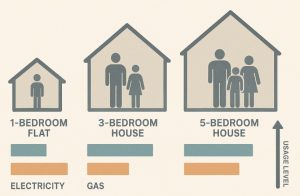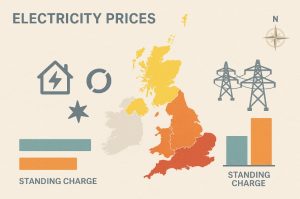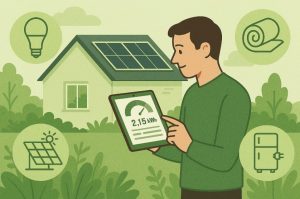Understanding the average electricity bill for a 3-bedroom house in the UK is vital for homeowners and renters who want to budget effectively.
Energy prices have seen significant fluctuations over the past few years, driven by changes in the global energy market, national policy, and household consumption habits.
For an average home, especially one with three bedrooms, monthly bills can differ depending on factors like energy provider, regional rates, and how energy-efficient the property is.
This article provides a complete breakdown of what you can expect to pay in 2025 for electricity in a typical 3-bedroom house in the UK. It also offers insight into what drives these costs and how you can manage them.
What Is the Typical Electricity Usage for a 3-Bedroom House in the UK?

A standard 3-bedroom house in the UK typically accommodates two to three occupants. Based on Ofgem’s 2025 guidance, such a household uses approximately 2,700 kilowatt-hours (kWh) of electricity per year. This equates to around 225 kWh per month under average conditions.
Electricity consumption depends on several key factors:
- Whether the home uses electricity alone or in combination with gas
- How energy-efficient the property is
- The number and type of appliances in daily use
In homes that are entirely electric without gas for heating or cooking, annual electricity usage can reach or exceed 4,500 kWh. This is particularly common in flats and newer developments where electric heating systems are installed instead of traditional boilers.
Smart meters have become widespread across UK households. These devices provide real-time information on electricity consumption, helping users to monitor patterns, identify wasteful habits, and better manage their bills.
How Much Does the Average Electricity Bill Cost for a 3-Bedroom House?
The average cost of electricity in a 3-bedroom home depends largely on how payments are made. Common methods include Direct Debit, Pay on Receipt of Bill, and Prepayment (PAYG).
Each method comes with varying pricing, with Direct Debit often being the most cost-effective due to reduced administration for providers.
Electricity Bill Breakdown by Payment Method
| Payment Method | Annual Cost | Monthly Cost |
| Direct Debit | £893.65 | £74.47 |
| Pay on Receipt | £951.12 | £79.26 |
| Prepayment (PAYG) | £871.17 | £72.60 |
While these costs reflect average usage (2,700 kWh annually), actual bills can vary considerably. Factors such as appliance usage, working from home, and heating type can all increase or decrease your electricity consumption.
For example, households using electric-only heating may see annual electricity bills of over £1,200. Those with energy-efficient insulation and LED lighting might reduce their consumption enough to save more than £100 annually.
What Are the Electricity and Gas Usage Estimates by Household Size?

The size of a household has a significant influence on both electricity and gas consumption. As the number of occupants increases, so does the demand for energy to power appliances, heat water, and maintain a comfortable indoor temperature. The property size and type of heating system, whether it’s gas-powered central heating or fully electric, also play crucial roles in determining overall usage.
In the UK, typical energy usage benchmarks are based on the number of people living in a home and the number of bedrooms. These benchmarks help energy suppliers and consumers estimate expected consumption and choose the right tariff plans. Below is a breakdown of average annual electricity and gas usage by property size and occupancy:
Average Annual Energy Consumption by Household Size
| Property Type | Typical Occupancy | Electricity Usage (kWh/year) | Gas Usage (kWh/year) |
| Flat or 1-Bedroom Property | 1–2 People | 1,800 | 7,500 |
| 3-Bedroom House | 2–3 People | 2,700 | 11,500 |
| 5-Bedroom House | 4–5 People | 4,100 | 17,500 |
These figures, while averages, offer a useful reference point for understanding how energy demand typically scales with household size.
Key Considerations That Affect Energy Usage by Household Size
Even within the same property size, energy usage can vary due to lifestyle choices, appliance efficiency, and heating preferences. For example:
- Cooking and Laundry Frequency: Larger families are likely to cook more meals and run washing machines and dryers more frequently, raising electricity usage.
- Heating Needs: A 5-bedroom house will generally require more energy to heat, particularly if it includes multiple bathrooms and larger living spaces.
- Work-from-Home Setup: Homes with remote workers or stay-at-home parents will experience higher daytime electricity usage due to lighting, electronics, and heating.
- Children or Elderly Residents: These groups may increase heating and lighting usage, particularly during daytime hours when adults in other households may be at work.
- Electric-Only Homes: In properties without a gas supply, such as some flats and modern developments, all heating, hot water, and cooking is powered by electricity, often doubling the average annual consumption.
Differences Between Electricity and Gas Usage
- Electricity is generally used for appliances, lighting, entertainment systems, and in some cases, heating and hot water.
- Gas is more commonly used for central heating and hot water production in traditional UK homes. Because heating and hot water are the largest energy demands, gas usage often far exceeds electricity usage in households that use both fuels.
To illustrate this further, a 3-bedroom home with two to three residents typically consumes about 2,700 kWh of electricity and 11,500 kWh of gas annually.
That makes gas consumption more than four times higher than electricity in a dual-fuel home. This ratio shifts dramatically in fully electric homes, where electricity consumption could reach 4,500 to 6,000 kWh per year due to the absence of gas.
Seasonal and Regional Factors
Energy usage by household size can also be influenced by:
- Seasonal Variations: Winter months see higher heating demand, leading to spikes in gas (or electricity, for electric-only homes) consumption.
- Regional Climate: Homes in colder parts of Scotland or northern England may use more energy year-round compared to those in southern regions with milder climates.
- Home Insulation: Well-insulated homes maintain temperature more efficiently, which can help stabilise energy usage across seasons regardless of household size.
Why These Estimates Matter?
Understanding your expected electricity and gas usage by household size is essential when:
- Choosing an energy tariff or provider
- Setting up a new account in a rental or newly purchased home
- Budgeting monthly household expenses
- Exploring upgrades like insulation or energy-efficient appliances
Energy suppliers often base their standard tariffs and estimated monthly payments on these national usage averages. If your household’s usage is significantly above or below these benchmarks, it may indicate a need to reassess your habits or the energy efficiency of your home.
How Do Regional and Tariff Variations Impact Your Electricity Bill?

Regional price differences are a standard feature of the UK energy market. Distribution network operators (DNOs) manage infrastructure within specific regions and apply distinct charges for delivering electricity.
Households in remote areas such as the Highlands or rural parts of Wales typically face higher network charges. In contrast, more densely populated areas often benefit from reduced delivery costs due to infrastructure efficiency.
Another key variable is the type of tariff selected. The two primary options are:
- Fixed Tariffs: Prices remain constant over a contract term, offering protection against market fluctuations.
- Variable Tariffs: Prices can change in response to wholesale market movements, sometimes offering lower costs but with potential for increases.
Most households are currently covered by the energy price cap introduced by Ofgem. As of 2025, this cap provides a level of price protection on standard variable tariffs but does not guarantee the cheapest rate available.
What Contributes to the Total Electricity Bill in the UK?
An electricity bill in the UK consists of various components beyond just the units of energy used. Each segment contributes to the final amount shown on the bill.
Typical cost breakdown includes:
- Wholesale Energy Costs: The price suppliers pay to purchase electricity from the market, making up approximately 38% of the total bill.
- Network and Infrastructure Charges: Around 25%, covering the maintenance of cables and substations.
- Operational Expenses: Including metering and billing, these represent about 17%.
- Policy Costs: Roughly 8% goes toward government initiatives such as the Warm Home Discount and support for low-income households.
- VAT: Domestic electricity is charged at a reduced VAT rate of 5%.
- Supplier Margin (EBIT): The final portion, usually around 7%, accounts for supplier profit after all other costs.
Bills also include a unit rate and a standing charge:
- The unit rate is the cost per kWh used, typically between 23p–25p in 2025 depending on region and provider.
- The standing charge is a fixed daily fee, currently ranging from 50p to 60p, and is payable regardless of how much electricity is consumed.
What Can Increase or Decrease Your 3-Bedroom Home Electricity Bill?
Electricity bills for a 3-bedroom house are rarely consistent year-round. A range of factors can cause fluctuations from month to month:
- Heating Source: Electric heating is costlier than gas, especially in winter.
- Appliance Efficiency: Older appliances consume more energy than newer, energy-rated models.
- Property Insulation: Poorly insulated homes lose more heat, leading to higher electricity usage if electric heating is in use.
- Occupant Habits: Homes with people working remotely or spending more hours indoors use more power.
- Seasonal Changes: Winter months see higher demand for heating and lighting, increasing average consumption.
Energy-conscious households may lower their bills by:
- Turning off appliances at the socket when not in use
- Upgrading to energy-efficient white goods
- Replacing halogen bulbs with LEDs
- Using thermostats and smart plugs to control consumption
How Can Homeowners Save on Electricity Bills?

Reducing electricity costs is achievable without compromising comfort or convenience. Making smart upgrades and using technology can lead to meaningful savings over time.
Here are a few effective ways to manage your household energy consumption:
- Install Smart Meters: Gain visibility over your daily and hourly energy use.
- Opt for Energy-Efficient Appliances: Look for A-rated refrigerators, washing machines, and dishwashers.
- Improve Insulation: Draught-proofing and proper loft insulation reduce the need for constant heating.
- Use Programmable Thermostats: These allow better temperature control and efficient scheduling.
- Switch to Cheaper Tariffs: Use comparison sites to find and switch to competitive energy providers.
Government-backed incentives and schemes may also offer financial support for insulation or home energy assessments. In 2025, initiatives such as the Energy Company Obligation (ECO4) and Great British Insulation Scheme are active to support qualifying households.
Why Should You Compare Energy Providers Regularly?
Energy providers update their tariff structures frequently, making it worthwhile for consumers to review and compare offers on a routine basis.
Households on standard variable tariffs are often subject to price fluctuations and typically do not benefit from the best available rates. By comparing deals every 6 to 12 months, homeowners can avoid unnecessary overpayments.
Benefits of switching providers:
- Potential annual savings of £150–£300
- Access to fixed tariffs for price certainty
- Better customer service and digital account management tools
- Renewable energy options for sustainability-focused households
Comparison websites allow quick side-by-side evaluations of unit rates, standing charges, and customer feedback. Many even facilitate the switch process, making it simple and hassle-free.
Conclusion
The average electricity bill for a 3-bedroom house in the UK sits between £72 and £79 per month depending on the payment method. While this figure offers a general guide, actual costs will vary depending on energy use, efficiency measures, and tariff choice.
With energy prices remaining unpredictable, tracking usage, improving efficiency, and regularly reviewing your provider can go a long way in managing household energy expenses. Homeowners are encouraged to stay informed, use smart technologies, and explore better deals to ensure long-term savings.
FAQs
How much does electricity cost per kWh in the UK in 2025?
As of 2025, the average electricity price in the UK is approximately 24 pence per kWh under the Ofgem price cap for standard variable tariffs. Rates vary by provider and region.
What’s the average standing charge for UK households?
The standing charge for electricity typically ranges between 50 to 60 pence per day, depending on your location and provider.
Is it cheaper to be on a fixed tariff or variable rate?
Fixed tariffs can offer stability, while variable rates may be cheaper during periods of low wholesale prices. The best option depends on market conditions and personal risk preference.
How does Economy 7 affect my electricity bill?
Economy 7 offers cheaper rates during off-peak hours (usually at night), which can benefit households that use electricity heavily during those hours, such as for storage heating or overnight charging.
Why do bills vary across different regions in the UK?
Regional price differences are due to network maintenance costs and distribution fees, which are higher in remote or less populated areas.
Can I reduce my electricity bill by using smart appliances?
Yes, smart appliances optimise energy use and offer better control over consumption. They can reduce unnecessary electricity usage and help lower your overall bill.
Are government energy support schemes still active in 2025?
Yes, schemes such as the Warm Home Discount, Great British Insulation Scheme, and Energy Company Obligation (ECO4) are still active to support eligible households in improving energy efficiency and reducing costs.






